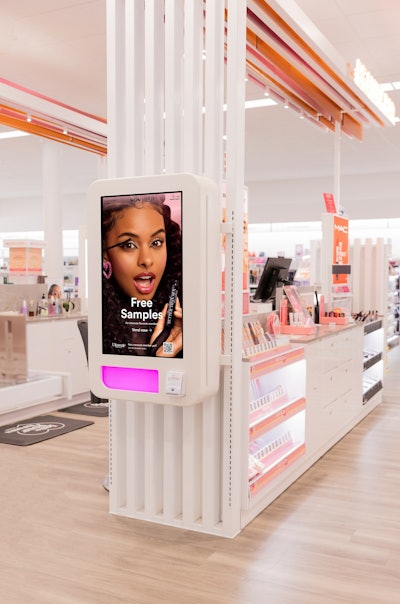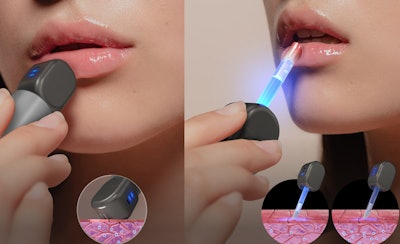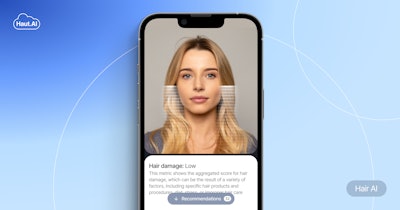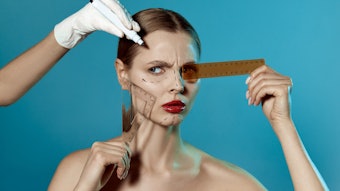
Beauty and technology are increasingly inseparable. From R&D and product development to marketing and logistics, digital innovation is central to the industry’s next phase.
 Ulta Beauty recently began testing SOS smart vending machines in 10 cities across the U.S. market to expand its in-store sampling program.
Ulta Beauty recently began testing SOS smart vending machines in 10 cities across the U.S. market to expand its in-store sampling program.For instance, Ulta Beauty recently began testing SOS smart vending machines in 10 cities across the U.S. market to expand its in-store sampling program. The retailer’s Ultamate Rewards members can claim one free travel-sized beauty product every week from the machines, which will also offer complimentary Rael period care products.
Elsewhere, CES 2024 has offered a preview of emerging beauty tech and thought leadership, including innovations from Amorepacific and a keynote from L’Oréal CEO Nicolas Hieronimus, who will reportedly address “inclusive and accessible beauty tech," according to CES, highlighting the need for "personalized expressions of self.” The executive’s key topics will reportedly include AI and data analysis, supporting consumers with physical challenges, and more. In addition, Nimble will exhibit what is touted as the “first smart at-home nail salon” device.
 CES has presented its 2024 Innovation Award to Amorepacific’s Lipcure Beam technology, which reportedly combines lip diagnosis, care and makeup capabilities in one unit.
CES has presented its 2024 Innovation Award to Amorepacific’s Lipcure Beam technology, which reportedly combines lip diagnosis, care and makeup capabilities in one unit.This reaction between the light and the deposited material reportedly strengthens the collagen fibers inside the lips, forming a moisturizing barrier on the surface. The result is slowed lip aging, per Amorepacific. The design supports one-handed application, key to accessibility, and “employs a universal color system naturally suited for all races and ages.”
These and other examples have inspired Global Cosmetic Industry to launch this new recurring beauty technology trend report, rounding up the latest tools and platforms launched by brands, suppliers and other stakeholders, offering a general overview of where the industry is going next.
3 Keys to AI’s Next Phase
 AI will reshape trend tracking, product innovation and more.girafchik
AI will reshape trend tracking, product innovation and more.girafchik1. Nimble Trend Scouting
Spate has launched its first generative AI report, detailing trends across 12 categories. Leveraging the ChatGPT platform, Spate is now able to analyze “billions of search signals across beauty, fashion, arts and entertainment, food and beverage, social issues, design, sports, tech, events, finance, home, and pets.”
The report unearths a wide array of insights, including the simultaneous decline in search activity around luxury beauty products and a rise in search terms related to social security and debt relief, perhaps signaling a “shift from luxury or extravagant consumption toward essential or value-driven consumption.” The report also reveals a “hunger for authenticity and individuality,” a “desire to reconnect with nostalgic experiences,” and “a growing desire for self-improvement, resilience and personal agency” in a world that feels more and more uncertain.
The report covers Google Search data for the 12 months ending April 2023 and represents Spate’s ability to simultaneously unearth insights across many sectors to present “a holistic view of consumer behavior” that breaks out of the vacuum of any one sector and which can assist brands in aligning with the complexity of changing consumer demands. By using the generative AI tool, Spate is also reportedly able to produce insights quickly and accurately, despite the analysis of massive datasets. These reports can be customized based on sectors and business needs.
2. Boosting Diagnostics & Personalized Shopping
 Haut.AI, developer of generative AI platform SkinGPT and a hair analysis SaaS, has received €2 million in external funds from strategic investors LongeVC and from Grupo Boticario shareholders' VC arm.
Haut.AI, developer of generative AI platform SkinGPT and a hair analysis SaaS, has received €2 million in external funds from strategic investors LongeVC and from Grupo Boticario shareholders' VC arm.The fundraising will reportedly support Haut.AI in expanding and scaling its no-code skin care e-commerce personalization software, as well as R&D for multimodal generative artificial intelligence for skin analysis.
The technology reportedly has the potential to detect skin issues early and recommend personalized solutions via shopper selfies. The platform can offer similar solutions for hair wellness. In addition, generative AI has the potential to render the entire product shopping experience for these product categories far more exact and effective.
Haut.AI's skin imaging datasets comprise more than 150 biomarkers, more than 3 million images and more than 1 billion data points, according to the company, for “unparalleled skin diversity.”
In May 2023, Haut.AI announced SkinGPT, a virtual skin care try-on that enables image-to-image simulation of any skin condition using clinical claims.
3. AI-enabled Inclusivity
At a moment when corporate inclusivity is facing increased scrutiny and court action, the AI-driven SeeMe Index has emerged to rate the relative inclusivity of brands based on consumer-facing efforts.
The platform “measures representation in advertising, product lines and external DEI commitments across six identity dimensions, including gender expression, age, skin tone, observed sexual orientation, body size and visible disability,” according to SeeMe.
While a number of high-profile brands have been highly rated by SeeMe for their DEI initiatives—including M·A·C Cosmetics, Dove, Esteé Lauder, L’Oreal Paris, NYX Cosmetics, Maybelline, Fenty Beauty and Fenty Skin, and e.l.f.—people with darker skin tones are still averaging 4x less screen time in beauty ads industry-wide than their lighter-skinned counterparts.
Furthermore, larger body sizes only make up 2.9% of people shown in beauty ads, according to SeeMe, while people aged 55 years and older represent just 0.8% of people shown.
Founded by former Google executives Asha Shivaji and Jason R. Klein, the SeeMe platform was developed to simplify inclusivity-related decision-making for marketers by bringing data-based insights into a space that lacked any such resources.
The insights surfaced by the SeeMe platform can both benchmark brands and provide a pathway for increased inclusivity, according to the organization. The scoring also allows brands to badge themselves with the SeeMe Index Seal of Approval, which can allow consumers to assess brands based on their own values.
Augmented Reality for Enhanced Shopper Engagement
Google has launched new AR Beauty tools that allow shoppers on the search platform to virtually try on hair color. According to Google, consumers interact 10% more with products featuring AR try-ons compared to conventional product pages. AR could be particularly effective for products that are highly individual-dependent. Brands like L’Oreal, Splat and Revlon are currently leveraging the platform. Google has also launched a virtual foundation try-on capability, as well as AR for lip and eye makeup for the mobile web. Google users are able to use these AR tools from any mobile browser in the United States. Google’s AR Beauty shopping ad capabilities, meanwhile, can replace a static product image with an interactive experience, per the company.










